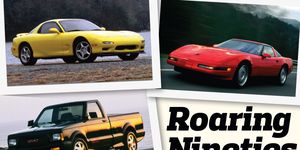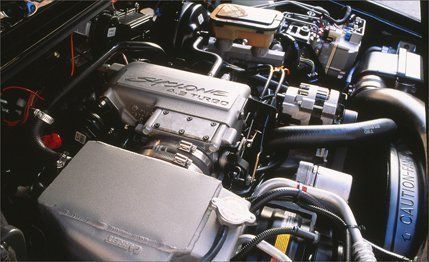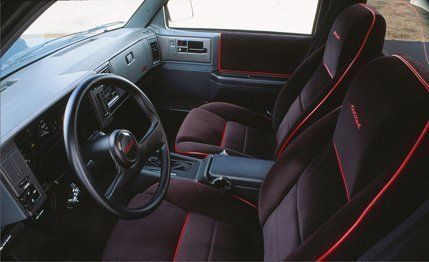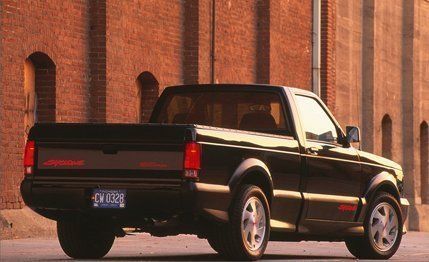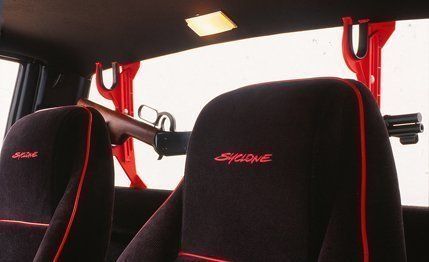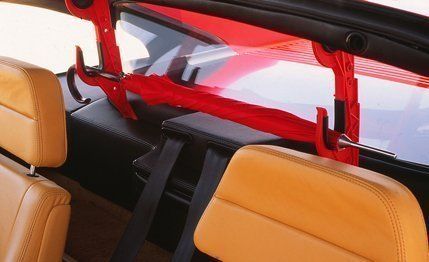From the September 1991 issue of Car and Driver.
We’ll try to keep this discreet—your mother might be reading—but, just between us guys, we all know that half the fun of a fast car is standing on the pedal, pivoting those throttles wide open, and seeing the goat in the next lane back out of your peripheral vision as if he had it in reverse. Adios, hairhat.
It gets better. Can we agree that a fast car rises to its highest and best use when you take the guy’s money, too? Better yet, get his pink?
Street racing for keeps may come down to a mighty horsepower shoot-out, but it begins on a different note entirely—it begins with a con. Success relies on the art of selling a losing proposition. You look for the swaggering sort and you show just enough to get him interested—not enough to make him wary. You have to act a little dumber than he actually is.
Pickup trucks are a pretty dumb act. Dress them up however you want; anything that can haul a month’s worth of horse food in one trip is still the rube from Omaha. Heh, heh.
Do you think they’ve heard about the GMC Syclone down at the fern bar? How about over at the racquetball courts? Let’s dare to think big. How high on the swagger ladder could you sell a losing proposition if you played the rube to full John Goodman dimensions? Uh, have they heard of the Syclone over in Maranello?
The Syclone, in case you haven’t heard either, is a little black GMC pickup, hunkered down over bulging Firestones, sort of like a street punk in a muscle T-shirt. Its alloy wheels are flashy bright and its red-splash “Syclone” decals could be the latest look in lick-’em-‘n’-stick-’em super-graphics. Born in the U.S.A.—in Shreveport, Louisiana, to be exact—the Syclone is your basic prairie ploughboy in Saturday-night-fever duds. One look at this piece and you expect to hear “boompa, boompa, boompa” from half-ton woofers. Talk about a ruse.
Because, under the black muscle T-shirt is—surprise!—genuine bad-ass, street-fighter muscle. This truck has specifications!—hardware that’ll make fast cars cringe. It has power: 280 horsepower at 4400 rpm, from 4.3 liters of V-6, turbocharged to 14-psi boost and liquid-intercooled. It has traction: full-time four-wheel drive with a center differential and a viscous coupling that distributes 35 percent of the torque to the front wheels, 65 percent to the rears. There’s also a limited-slip differential in the rear axle. Moreover, the Syclone has a transmission that makes the best marriage between the power and the traction. It’s a four-speed automatic. The torque converter hastens the engine into its best-boost range, thereby minimizing turbo lag; it also prevents the smoky clutch death that’s all too likely when you try to take advantage of four-wheel-drive traction to hustle off the line.
The way pickups stop is usually far more exciting than the way they go, but the Syclone has the answer for that predicament too. It has ABS brakes as standard equipment. Dog-dish size (9.5inch-diameter) drums are used at the rear—not too impressive until you notice that this vehicle, when empty, has only 37.1 percent of its weight in back. And empty is the way it’ll usually be driven. Under hard braking, most of the tire loading will transfer forward, so the drums really don’t have much to do back there.
The Syclone has the hardware to be about the baddest street cleaner to roll off a Detroit showroom in 1991. Yet everybody’s two eyes say it’s just a punk pickup truck all togged out in the latest off-the-rack fashions from Pep Boys. A scam like that should take in more green than a seat in Congress.
The deal is this. We go by two-lane blacktop rules. Money in front. From a standing start, we’ll cover 1320 feet. On three. One pass. Winner takes all.
As we said earlier, racing for bucks comes down to the art of selling a losing proposition. And you want to sell big the first time because the word gets out fast.
Ferrari guys have big money. And a lot of swagger. They’re used to everybody genuflecting in their presence. Would a cocky 348t owner—high on adulation and on rippah, rippah noises from his prancing-horse, mid-engine V-8—deign to put it on an uppity pickup truck?
Is the Pope a bachelor?
We’ll spare you the sales script to arrange this match. What matters is the outcome. And according to electronic witnesses, here’s the play-by-play.
Is the road secure? Yes. The Ferrari makes two tire burns, just to get a feel for the grip.
Waarrreeeeeee.
Waarrreeeeeee.
With just over 60 percent of its weight on its wide 255/45ZR-17 rear Bridgestones, the Italian has no problem hooking up. The driver decides he needs 4500 rpm showing on the tach when he drops the clutch, just to keep from bogging.
The trucker, he just smiles. Don’t wanna put no heat in the intercooler.
They line up.
One!
Rippah, rippah.
Two!
Riiiippaah.
The truck shudders.
It seems to clench up against the brake. A hissing, whirring, hurting tornado of a sound builds under its black hood.
Three!
Waarrreeeeeee. The Bridgestones go to blur. A gray-blue haze forms at the tread patch. The Ferrari makes a perfect launch.
When the truck brakes come off, full-boost torque is downloaded to all four wheels. They barely slip. Acceleration begins with such a jolt the driver feels his breakfast slosh rearward. In a blink, the Ferrari is looking at tailgate. And the tailgate is getting smaller. Half a car-length, one, two car-lengths of daylight between them before the Ferrari tops out of first gear. The race has just begun and already it looks like a massacre.
Levering through the maze of a Ferrari’s manual transmission is always tricky, but the guy is good. No pickup truck is going to take his candy. In second gear, his singing V-8 seems to jump tempo, allegro to presto. The tailgate has stopped shrinking. But it’s not looming larger, either.
Compared with the Italian, the truck is nearly soundless. But its shifting is tricky, too, because the revs rise quickly and the limiter will call a complete ceasefire at 4700 rpm sharp (500 rpm below the redline). To squeeze out the last useful rev in the torque curve, the driver tries to shave the interrupt penalty as close as he can. He pushes the lever at 4450. The gear changes are completed barely in time.
In third, the Ferrari begins to show its breeding. It’s recouping its losses. The truck is straining its burly shoulders against the wind. The air can be bulled aside, but the effort takes away from acceleration.
The end marker is coming up. The slippery, wind-cheating Ferrari is into its element now, gobbling up the gap. Can it break through in the final kick? Its four-cam, 32-valve, all-aluminum V-8 engine, the pride of Maranello, screams with the pain of effort.
No! The truck wins.
Get ready for the loser’s weasel.
“One more time, half a mile this time around.”
“Nope.”
“Okay, same distance, but start from a roll this time.”
“Nope.”
The savvy racer knows his game, and he sticks to it.
The Syclone will beat a brand-new $122,000 Ferrari 348ts. No doubt about it. If the script is right. Be careful of heat though, because temperatures above, say, 75 degrees, cause significant power losses. On cool days, the Syclone’s turbo, torque converter, and adhesive-tape traction are devastating from zero to 60. Above 80 mph, it pays for its truck shape. It clears the quarter-mile in 14.1 seconds, compared with 14.5 seconds for the Ferrari, but the Ferrari is moving 6 mph faster (99 mph versus 93). The Ferrari grabs the lead very soon after the quarter and never looks back. Its top speed is 166 mph. The Syclone’s is 126.
But, hey, that’s a different race. This is America, the land of go on green, and that’s the game we play to lighten the pockets of the unwary. For American running, the Syclone has the cards. It’s king of the traffic-light Grand Prix.
It also happens to be pretty darn good at the other moves we Americans expect of sports cars. It beats the Ferrari at braking, too, drawing to a stop from 70 mph in 183 feet, four feet shorter. Cornering grip is less but, at 0.80 g, it is still respectable. If results count more than labels, the GMC Syclone is truly a sports car too that will have to be reckoned with.
You may choke on the idea of a truck-shaped sports car. It’s a provocative idea, we admit. But what is a sports car, anyway? If you go back over precedent, if you collect all the Austin-Healeys and Porsches and Jaguars and Corvettes and Lotuses and any Ferrari you care to name—a pretty representative cross section of genuine sports cars, wouldn’t you agree?—all they really have in common is a cockpit for two and a compelling sort of Reebok agility. The Syclone does exactly that.
Okay, real sports cars have more. They have an exclusivity that comes from special machinery and limited production. And they ride hard.
Again, the Syclone qualifies. All-wheel-drive grip on the road was simply awe-inspiring on the megabuck, not-legal-here Porsche 959. Yet you can’t get it on any other sporting two-seater today. So the Syclone has exclusive mechanicals. It has rarity too—only 3000 are planned for production. And the ride quality is lumpy enough to be right down there with any red two-seater on earth.
Okay, you’ve heard our best rationalizations, now let’s have a show of hands. How many of you agree that the Syclone is a sports car?
Uh, not many. Maybe that’s why—aside from dropping the hammer on Ferraris—the most fun thing about the Syclone is arguing what role it plays in the greater automotive pageantry. This little cross-dresser refuses to stay in any single category.
It looks like a truck, and in that assignment it’s next to hopeless. Warnings inside the tailgate and in the owner’s manual forbid loads in excess of 500 pounds under pain of “damage to drivetrain and suspension.” There’s not much suspension travel left after all the lowering that went on to get the hunkered-down look. Moreover, the springs front and rear have been softened to approximately passenger-car rates. The result is a ride that’s a bit jouncy but surprisingly un-trucklike. Carrying much extra weight, though, would quickly use up the remaining suspension travel.
Besides, anything you throw in back (after unsnapping the tonneau and removing its support ribs) had better be soft as a bag of chicken feed. Otherwise it’ll fly around the box like shrapnel when you yield to the Syclone’s enthusiasm for quick direction changes.
Because, never mind the looks, what you feel in the Syclone is the same kind of cut-and-run agility that made sports cars so much fun in the first place. Actually, the Syclone does it better than most, particularly better than a Ferrari. You can reach the Syclone’s steering wheel—not just the bottom but all of it—and the power assist lets you grab big angles fast. But you don’t need big angles, because the 50-series Firehawk SVXs on 8.0-by-16-inch wheels respond sharply. This truck feels like it could dodge oncoming bugs before they hit the windshield.
And—amazingly—do it without ever chirping a tire. In any sports car, but particularly the powerful ones, you’re always aware of the tires. They scratch for traction. You feel the slip angles and drifts—and the slightly squirmy fishtails when you go wide open in first gear. That sensation is missing in the Syclone, as if it had some papal dispensation from the laws of physics. What you feel is a composure that’s obtainable only with phenomenal traction. At metro-traffic speeds, the Syclone is an Olympic-class rat racer.
Stay off the bumps if you can. The solid rear axle on leaf springs remembers a few old bugaloo steps now and again. Mostly, they cause discomfort rather than instability, because the amazing traction keeps everything in line. But they remind you that the Syclone is still first cousin of a truck.
The black cockpit with its red piping reminds of past Ferraris. But the Syclone’s controls are more agreeably placed. The leather-wrapped wheel is appropriate. The cloth buckets offer lateral restraint in proportion to the machinery below, and there are squeeze bulbs for pumping up the lumbar supports. We could use one more click in the recline direction on the backrest-angle adjuster, though.
Generally, the mood in the control room is pure Detroit. The console offers twin cupholders, and the speedometer promises only 120 mph. Still, the space accommodates two occupants more generously than many sports cars. Baggage larger than the thinnest of briefcases—and therefore too big for the foot spaces—will face tough going though. Not that the Syclone is without a trunk. Quite to the contrary, the luggage space available under the tonneau is so immense that your stuff will reach supercollider velocities before it thwacks the walls.
That is, unless you drive sensibly. But don’t make promises you can’t keep. The wonder of the Syclone is not so much a pickup that’ll do a Ferrari blur on the local scenery, although that’s no small trick. The real magic is the way it makes this capability seem like a perfectly wonderful idea.
Maybe, too, your mother will think it’s just a truck.
This content is created and maintained by a third party, and imported onto this page to help users provide their email addresses. You may be able to find more information about this and similar content at piano.io


